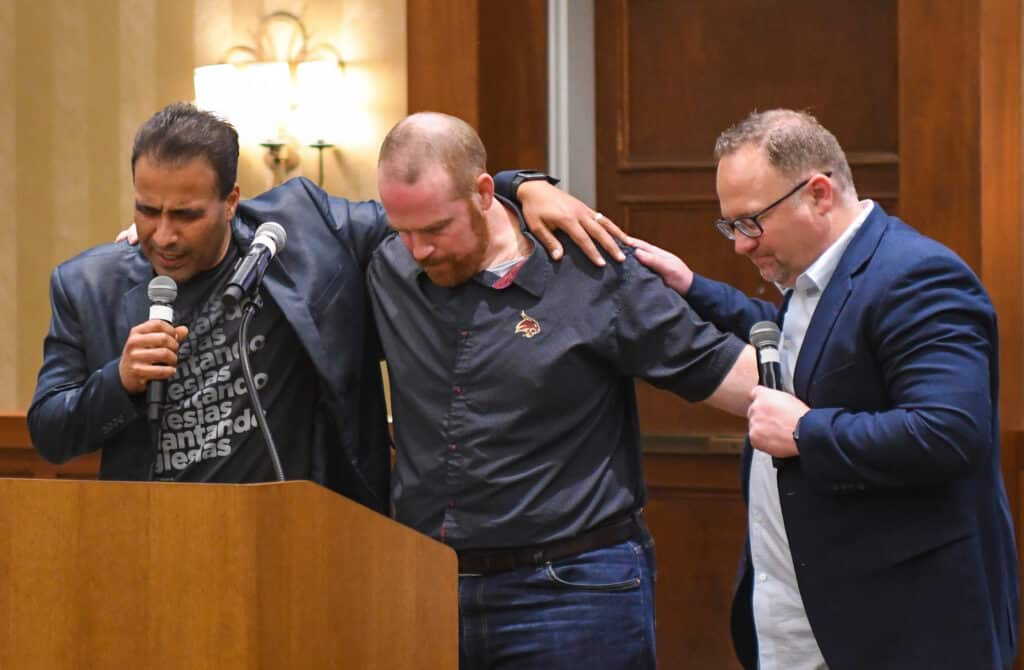One most often-cited and easily demonstrable reason for our denomination’s emphasis on church planting is the contention that new churches reach more lost people per 100 members than do churches over 15 years old. According to Professor J.D. Payne of Southern Seminary, new churches reach more than three times as many lost people as older churches.
Some mature churches do reach their hundreds, even thousands. Maybe you’ll think of a church of 30,000 members that baptizes 1,000 they win to the Lord each year. It sounds good, and a thousand baptisms would put even a large church near the top of SBC baptisms, but remember the ratio. At an average three baptisms per 100 members (according to Professor Payne), a church with 30,000 members would have to baptize 900 people just to be average. The fictional church noted above has baptized 3.3 per 100 members. It’s the same problem, only multiplied by 300. Church planting still seems like the best way to reach a community, even in a place with many churches that are no longer as effective as they once were in evangelism.
I don’t know why this is true. Over the period of my ministry, hundreds of books and thousands of articles have taken a shot at the problem. Some pastors have found notable success in their ministries but almost none of those who buy the books or attend the conference spawned by one church’s success are able to transfer the spark to their own ministries. “It’s a leadership problem,” many have said. “It’s a prayerlessness problem,” others chime in. Still others note the lack of outreach by many churches. Maybe the laymen need evangelistic training. Maybe we need revival in America. It’s hard to gainsay any of these ideas but some churches are doing better than others, seemingly based on being smaller and newer than the church in the next block.
Higher baptism rates are not the only reason to plant churches, by the way. In many places there are language groups that do not have a church that preaches the gospel to their culture or in their language. In other places, tens of thousands of people do not have a Bible-preaching church in their city. Most of the United States is not over-churched.
Do the characteristics of churches at different stages of maturity give us any clue for differences in evangelistic effectiveness? I think they might.
Smaller-newer churches don’t have enough money—Yes I know that a 40-year-old suburban church doesn’t have enough money either but that church spends 40 percent on personnel and another 30 percent or more on other fixed expenses. The newborn church can’t afford fixed expenses, yet. They have to do ministry without program money. They use what they have, people, every one of the 30-100 people they have.
Larger-older churches have obligations—They have a lot more ministry categories than their new sister churches. Each category needs a staff member to devote or split his attention to the success of the ministries contained therein. And each ministry has a constituency that will list that thing the church does as a very important reason that they attend the church. It becomes something the church must do, so long as they are able. Smaller-newer churches often look forward to the day when they can have a broader set of obligations. They can’t take them on, yet.
Smaller-newer churches are more motivated in evangelism—They need people. Yes, they strongly desire to see the lost come to Christ and so does the church down the block. The smaller-newer church also needs people to do the work and to fund the ministry. The Lord uses need to motivate us to do more energetically the things to which we’re committed already. A smaller-newer church has fewer distractions from the main thing in addition to a real need that may be less keen in churches that reached critical mass decades ago. J.D. Payne has also noted that the evangelistic effectiveness of a new church begins to decline after three years of life. Maybe the urgency fades a little at a time during the first decade.
Church planters are more likely to seek experienced help—The pastor of a mature church has decades of experience and has pastored two or more churches already. He’s less motivated to look for help. If, as many say, 80 percent of our churches are plateaued or declining, why aren’t 80 percent of our churches desperately seeking revitalization? Is complacency a temptation that follows experience?
No one goes to a new church plant to hide out—It’s a blessing of being smaller and newer that the church membership is thoroughly mixed up in the lives of brothers and sisters. The mature church, of 1,000 members or so, is a place where a person can usually attend and watch without anyone bothering him. It’s a difficult problem that grows with time as more and more people come and go or just come and sit. In that church of 1,000 members, nearly the same number of people are intimately involved in what the church does as in the newer church of 100. In the small-new church the percentage is near 100 percent. That drops with time and success, in most cases.
It makes me wonder why a church planter would ever look at another ministry and think, “someday.” But there is another way to look at it.
Mature churches are a resource—Remember those ministries and categories and staff members and fixed expenses? Well those are the things that make many community ministries possible. Smaller-newer churches may want to go to a youth camp planned by a staff member of the bigger-older church, in an office, in a building facilitated by some level of bureaucracy.
Mature churches give money to missions—The concept of missions is that more established ministries give to establish gospel outposts in less-reached places. Those are relative terms, but the life of a missionary or church planter or seminary student would be much more difficult without the missionary hearts of churches over 15 years old.
Larger-older ministries baptize hundreds of thousands each year—Their percentage effectiveness may, on the average, drop over time, but a lot of people are saved in mature churches.
Older churches currently minister in places where we’re not planting churches—Rural counties and small towns need love too. Unless we respect ministries in small traditional places, we’ll neglect the spiritual needs of millions of our countrymen. Our talk, even among our friends and co-workers, should indicate that even churches that might be gone in a generation are not yet gone or irrelevant.
Churches with a long history are tempted to forget their reason for being. I believe revitalization is possible if the church courageously focuses on first things. The focus, energy and almost desperate closeness of a new church start has much to teach churches that are dragged too often into maintenance. Older churches can reach people for Christ if they can shake off ossifying comfort. These churches have a responsibility to remain vital for the whole of their lives. In fact, their responsibilities grow as they are trusted with more influence and more resources.
From observation, it seems true that churches have life stages like people do. Some churches do remain healthy over the course of a hundred years but it’s rare. Most slow down and come to a stop long before that. That doesn’t mean they cease to have a purpose or that there is no hope, just that each stage of life has its own challenges. But if a church can be like a person, a denomination of churches can be like a family—an amazing collection of diverse individuals bound by cords not easily broken. Without new members, the family declines and without the generations of parents and grandparents, the young ones lack nurture. Like families, we also tend to take one another for granted or squabble over nothing. Let’s hear no more cynicism about the well-established need for church planting or, on the other hand, calling ministries different from our own “irrelevant.” It’s not the way families should talk about each other.














